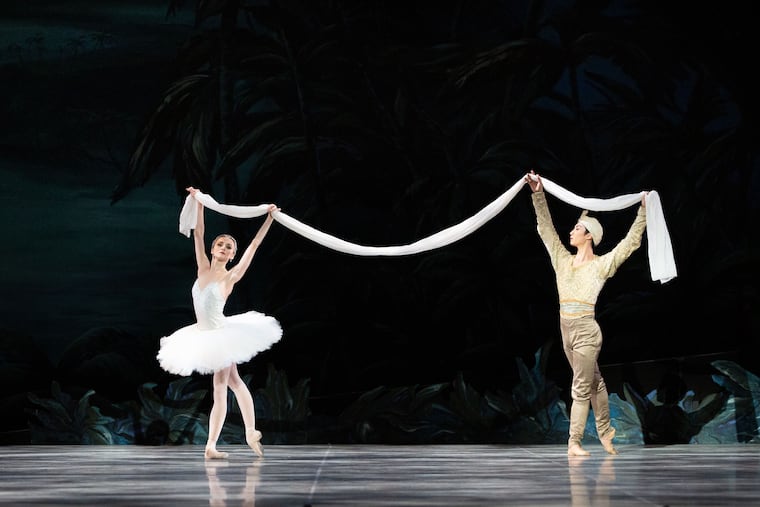Pennsylvania Ballet dishonors women by erasing them from its new season | Opinion
The 10th largest company in the U.S. has chosen to “honor” its female founder with a spring digital season that features zero pieces by women.

It is the spring of 2021, except in the ballet world, which is apparently stuck somewhere in a 1950s deep freeze, where classical dance celebrates women by muting them.
Our team at Dance Data Project was stunned to learn that the Pennsylvania Ballet, the 10th-largest company by budget in the U.S., has chosen to “honor” its female founder, Barbara Weisberger, with a spring digital season whose theme is “Strength. Resilience. Beauty,” and features three programs with 11 works by male choreographers and zero — yes, that is zero — pieces by women.
Classically based dance has already been sliding into irrelevancy as the audience becomes ever older. The Wallace Foundation’s 2017 “Building Millennial Audiences” study found that in the 18- to 34-year-old demographic, only 3% had been to a live dance performance in the previous year, down from 5% in 1992.
» READ MORE: Pennsylvania Ballet meets Electric Light Orchestra in a welcome return to the stage
It is surprising that major corporations, like the lead Pennsylvania Ballet donors Cigna, Reliance Standard Life Insurance, Alger, Amerihealth Administrators, Aramark, Blank Rome LLP, Doubletree by Hilton, Humana Foundation — all of which surely have policies supporting diversity, equity, and inclusion — feel comfortable with the complete exclusion of creative works by women from a season dedicated to celebrating a female entrepreneur.
Excluding women from a season honoring a woman is particularly egregious given that ballet is the most female of art forms. It is estimated that 70% of ballet audiences are female, as is the donor base.
Girls outnumber boys at up to 20 to 1 in ballet classes. Girls and young women are the economic backbone of the art form, paying full tuition for classes, funding ballet companies through summer intensives and preprofessional programs, and (unfortunately) serving at the bottom tier of compensation scales by working as “gig” teachers in ballet schools.
And the future is female: both globally and in the U.S., we are witnessing a generational transfer of wealth, with women currently holding $10 trillion of assets and set to inherit almost two-thirds of the anticipated $30 trillion in wealth amassed by the baby boomer generation. The new generation of philanthropists cares deeply about issues surrounding equity.
While it is heartening to see that the work of a female composer, Jennifer Higdon, was included in the program and that the choreographic roster includes multiple artists of color, racial diversity and the engagement of a single female musical collaborator do not compensate for the systematic exclusion of women dance makers.
This disappointing announcement from artistic director Angel Corella and executive director Shelly Power comes during a time when rehearsals and performances are virtual, and there exists an endless supply of both acclaimed and lesser-known female choreographers available to work with leading companies at a moment’s notice. It is also reminiscent of the 2018 controversy surrounding the “Femmes” program of Les Grands Ballets Canadiens, which featured an all-male lineup of choreographers for an evening of works promoted under a theme of women. After outcry and a petition, the program was rebranded.
Just as Les Grands Ballets could do better, Pennsylvania can do and has done better. In the company’s 2019-2020 season, the Pennsylvania Ballet premiered Yin Yue’s “A Trace of Inevitability,” and the second company was scheduled to premiere works by Samantha Dunster, Maria Konrad, and Ashley Walton before the COVID-19 pandemic forced the cancellation of their program. Why not bring these canceled works back or, better yet, commission these women to create yet another work on the company to celebrate a female founder?
It has been nearly five years since the New York Times published its groundbreaking article, “Breaking the Glass Slipper: Where Are the Female Choreographers?” In the article, the Pennsylvania Ballet was described as an “exception” to the large number of companies at which it was “rare to see works by women.” Much progress has been made at other companies since then, and conversation surrounding exclusion is at an all-time high. To remain exceptional, companies — the Pennsylvania Ballet included — must be proactive in their inclusion practices and held accountable for missteps when they inevitably occur.
Elizabeth “Liza” Yntema is the president and founder of the Dance Data Project (DDP). She serves on multiple boards of directors.